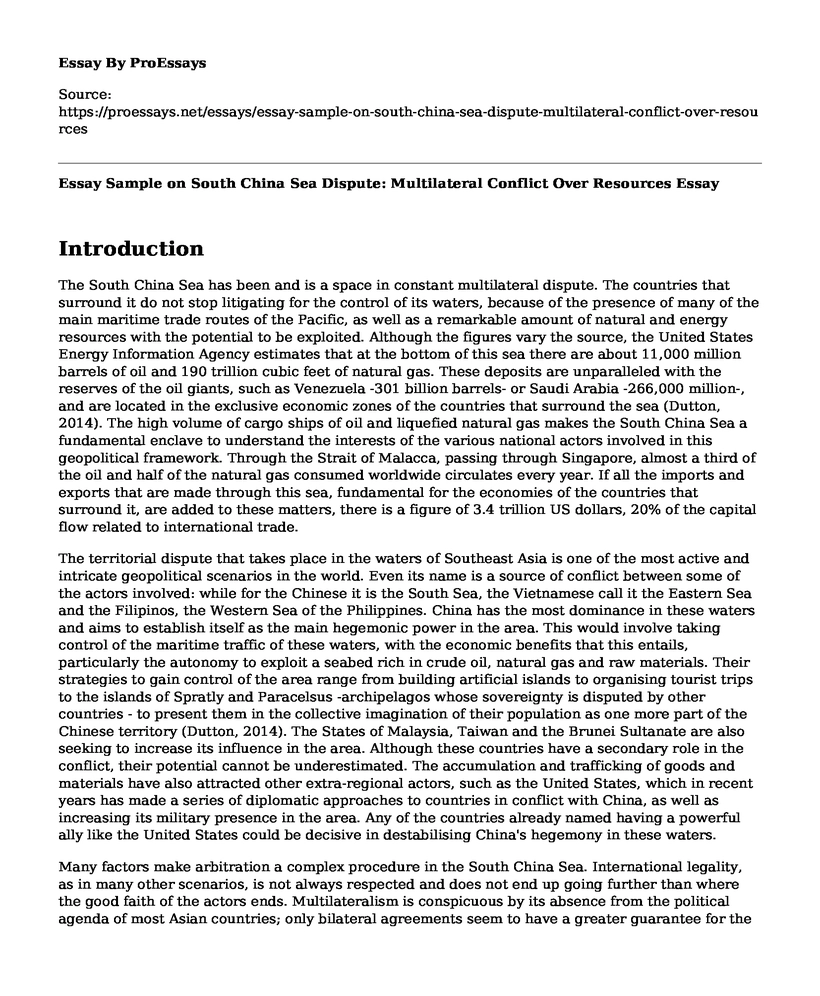Introduction
The South China Sea has been and is a space in constant multilateral dispute. The countries that surround it do not stop litigating for the control of its waters, because of the presence of many of the main maritime trade routes of the Pacific, as well as a remarkable amount of natural and energy resources with the potential to be exploited. Although the figures vary the source, the United States Energy Information Agency estimates that at the bottom of this sea there are about 11,000 million barrels of oil and 190 trillion cubic feet of natural gas. These deposits are unparalleled with the reserves of the oil giants, such as Venezuela -301 billion barrels- or Saudi Arabia -266,000 million-, and are located in the exclusive economic zones of the countries that surround the sea (Dutton, 2014). The high volume of cargo ships of oil and liquefied natural gas makes the South China Sea a fundamental enclave to understand the interests of the various national actors involved in this geopolitical framework. Through the Strait of Malacca, passing through Singapore, almost a third of the oil and half of the natural gas consumed worldwide circulates every year. If all the imports and exports that are made through this sea, fundamental for the economies of the countries that surround it, are added to these matters, there is a figure of 3.4 trillion US dollars, 20% of the capital flow related to international trade.
The territorial dispute that takes place in the waters of Southeast Asia is one of the most active and intricate geopolitical scenarios in the world. Even its name is a source of conflict between some of the actors involved: while for the Chinese it is the South Sea, the Vietnamese call it the Eastern Sea and the Filipinos, the Western Sea of the Philippines. China has the most dominance in these waters and aims to establish itself as the main hegemonic power in the area. This would involve taking control of the maritime traffic of these waters, with the economic benefits that this entails, particularly the autonomy to exploit a seabed rich in crude oil, natural gas and raw materials. Their strategies to gain control of the area range from building artificial islands to organising tourist trips to the islands of Spratly and Paracelsus -archipelagos whose sovereignty is disputed by other countries - to present them in the collective imagination of their population as one more part of the Chinese territory (Dutton, 2014). The States of Malaysia, Taiwan and the Brunei Sultanate are also seeking to increase its influence in the area. Although these countries have a secondary role in the conflict, their potential cannot be underestimated. The accumulation and trafficking of goods and materials have also attracted other extra-regional actors, such as the United States, which in recent years has made a series of diplomatic approaches to countries in conflict with China, as well as increasing its military presence in the area. Any of the countries already named having a powerful ally like the United States could be decisive in destabilising China's hegemony in these waters.
Many factors make arbitration a complex procedure in the South China Sea. International legality, as in many other scenarios, is not always respected and does not end up going further than where the good faith of the actors ends. Multilateralism is conspicuous by its absence from the political agenda of most Asian countries; only bilateral agreements seem to have a greater guarantee for the future. While China prefers bilateral negotiations in dispute resolution, many of its neighbors argue that China's relative size and influence give it an unfair advantage. The Philippines, on the other hand, opts for a multilateral agreement with ASEAN members to settle the South China Sea dispute (Dutton, 2014). This impasse not only complicates the possibility of reaching a solution that pleases countries that dispute for the region but also diminishes the role and relevance of the economic bloc itself in the remediation of the conflict. It is perceived that, despite the current impasse in the negotiations, any attempt to impose the decision by force would be equally useless. China has already demonstrated that it is unwilling to find a solution that meets its interests, including rejecting the decisions of the International Tribunal for the Law of the Sea. However, since the countries claiming the region, including China, are not willing to engage in a belligerent conflict, the possibility of an agreement is not ruled out. However, if a solution is found, all parties will have to demonstrate flexibility and ability to comply with a multilateral agreement.
References
Dutton, P. A. (2014). China's maritime disputes in the East and South China Seas. Naval War College Review, 67(3), 7-19. https://digital-commons.usnwc.edu/cgi/viewcontent.cgi?article=1289&context=nwc-review
Cite this page
Essay Sample on South China Sea Dispute: Multilateral Conflict Over Resources. (2023, Jan 04). Retrieved from https://proessays.net/essays/essay-sample-on-south-china-sea-dispute-multilateral-conflict-over-resources
If you are the original author of this essay and no longer wish to have it published on the ProEssays website, please click below to request its removal:
- Regionalism and Trade Liberalization
- IKEA: Making Life Better for the World's Many People Essay
- International Trade Logistics Essay
- Second-Hand Clothing Trade Essay Example
- Research Paper on Global Issues Influence on Domestic Policy
- CBP: Securing US Trade Through Maritime Ports - Essay Sample
- Essay Example on British Red-Cross: Helping People in Emergencies Worldwide







